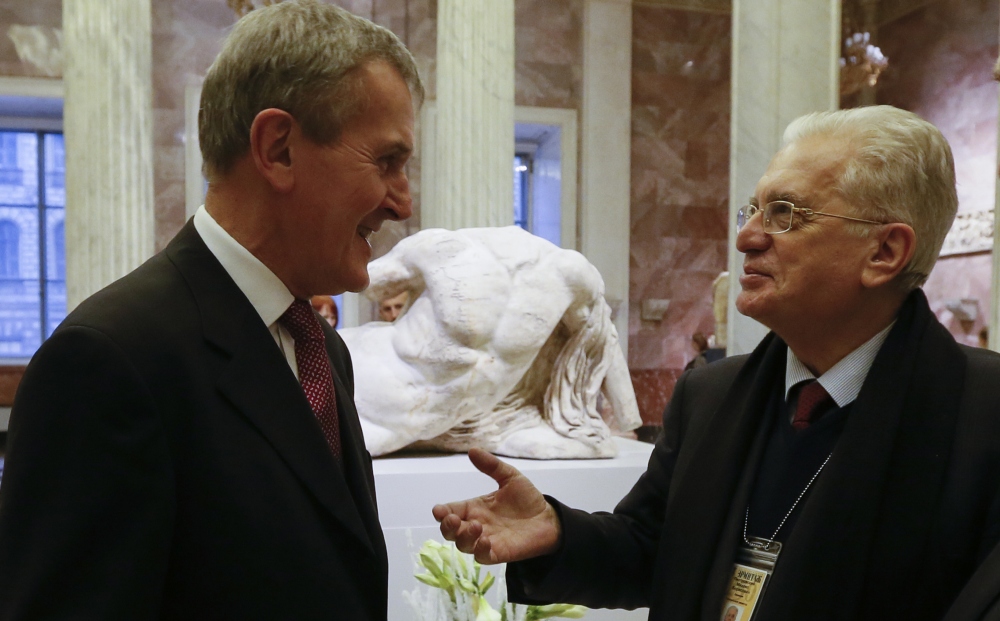One of the British Museum’s much-disputed Parthenon Marbles was unveiled Friday after being sent in secret to Russia — a surprise move that outraged Greece, which has long demanded the return of the artifacts.
The loan of the piece, an elegant depiction of the Greek river god Ilissos, was the first time in two centuries that any of the contested sculptures has left Britain — and raised questions of timing amid growing tension between Russia and the West over Ukraine and other disputes.
Greece reacted with fury.
“Greeks identify with our history and culture! Which cannot be sliced up, loaned or given away!” Greek Prime Minister Antonis Samaras fumed in a sharply worded statement punctuated with exclamation points. He described the British Museum’s move as a provocation.
The museum announced the loan only after the sculpture — a headless Ilissos reclining amid exquisitely carved drapery evoking river water — had been spirited to Russia’s Hermitage Museum in St. Petersburg. It will be on display Saturday through Jan. 18 as part of a major exhibition to celebrate the 250th anniversary of the museum, Russia’s most renowned.
The sculptures are at the heart of one of the world’s most famous cultural heritage disputes. The marbles graced the Parthenon temple on the Acropolis for more than 2,000 years, until they were removed at the beginning of the 19th century by Scottish nobleman Thomas Bruce, the 7th Earl of Elgin, when it was fashionable for the aristocracy to collect ancient art.
Greece contends they were looted illegally while the country was under Turkish occupation. The British Museum has long rejected their return, arguing that the pieces, sometimes known as the Elgin Marbles, can be seen in London by a global audience, free of charge.
In announcing the loan, the museum’s trustees described the sculpture as a “stone ambassador of the Greek golden age,” whose loan should continue despite the tensions between Britain and Russia.
“It is precisely because relations between the countries are difficult that this kind of loan is so important,” British Museum director Neil MacGregor told the BBC. “As we know, relations between Britain and Russia have been bumpy over the last couple of years. But the Hermitage has lent very generously.”
MacGregor added that he hoped the Greek government would be “delighted.”
“I hope that they’ll be very pleased that a huge new public can engage with the great achievements of ancient Greece. People who will never be able to come to Athens or to London will now here in Russia understand something of the great achievements of Greek civilization.”
The trip to the Hermitage marks the first time any of the sculptures have left the museum since being presented to its trustees by Parliament in 1816, with the exception of their evacuation for safekeeping in wartime.
The British Museum has said it will consider any request for any part of the collection to be borrowed with the precondition “that the borrowing institution can guarantee its safe return” — a condition Greece is unlikely to agree to.
Efforts to return the works were recently given a fresh boost by lawyer Amal Clooney, wife of actor George Clooney, who stepped in to back the Greek cause.
Britain’s government played no role in the loan to the Hermitage — the British Museum is independent of the government, a view it has often repeated as Greece sought to have the marbles returned.
The loan highlights a dilemma for Western museums that have substantial holdings of ancient art, which are often at the heart of their collections.
Returning such pieces would encourage other countries to seek the return of their treasures, said Beatrice Heuser, professor of international relations at the University of Reading.
“It would start a merry-go-round,” she said. “Everybody else would start claiming things as well.”
Departure of the marble to Russia also represents a calculated risk for the British Museum, said Keir Giles, a Russia expert and associate fellow at the Chatham House think tank.
Russian President Vladimir Putin may step in and return the sculpture to Greece, should it meet his political goals at the time, Giles said.
“The Hermitage, just like the British Museum, will set itself out as independent entity,” Giles said. “However in Russia, they may be given an offer they can’t refuse.”
The British Museum trustees underscored the connections to a cultural heritage shared by both museums, and the possibility the work could become the centerpiece of cultural diplomacy, despite tensions over Moscow’s annexation of Ukraine’s Crimean peninsula and support for pro-Russian separatists in the eastern part of that country.
While relations between the two nations may be frosty, the warmth between the leaders of the two museums was clear in St. Petersburg on Friday.
After a cheerful welcome, MacGregor and Mikhail Piotrovsky, director of the Hermitage, together cut a ribbon to the round hall called the Roman Yard, where the sculpture was placed on a pedestal.
“This display is the highest gesture of trust between the museums,” Piotrovsky said. “It is a symbol of friendship, trust and the significance of cultural ties.”
“No political situation should interfere in building bridges between cultures.”
Copy the Story LinkSend questions/comments to the editors.



Success. Please wait for the page to reload. If the page does not reload within 5 seconds, please refresh the page.
Enter your email and password to access comments.
Hi, to comment on stories you must . This profile is in addition to your subscription and website login.
Already have a commenting profile? .
Invalid username/password.
Please check your email to confirm and complete your registration.
Only subscribers are eligible to post comments. Please subscribe or login first for digital access. Here’s why.
Use the form below to reset your password. When you've submitted your account email, we will send an email with a reset code.